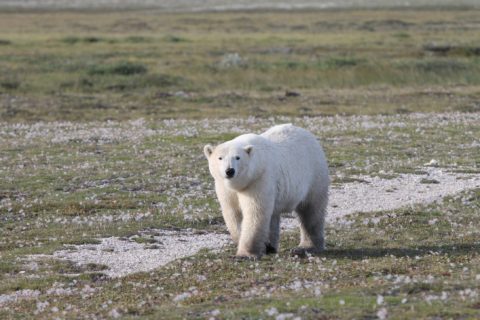At the University of Saskatchewan, many students never get the chance to explore their research interests through a hands-on approach. In the arctic field school program, students not only specialize in arctic studies but also present their research to Parks Canada and the general public at the end of their program.

On the arctic field school program, Jessica Goddard captures a lone polar bear on the move, a unique opportunity for a U of S student.
Arctic field school is a two week intensive program in Churchill and Wapusk National Parks in Manitoba that engages undergraduate students with a research project of their own choice on a topic related to arctic animals. Students enroll in the three credit course Animal Bioscience 475: Field Studies in Arctic Ecosystems and Aboriginal Peoples. They submit a research proposal before the trip so that they can research their topic and collect and analyze their data during the trip.
Dallis Aiken, a student in her final year of animal biosciences in the College of Agriculture and Bioresources, shares how unique this program is within the animal bioscience course options.
“It’s the most diverse animal bioscience program and it’s hardly a class. It’s very much a field class; there’s not a lot of lectures and barely any note taking at all. There’s just tasks you have to accomplish through the program,” Aiken said.
The field school accepts students from the U of S and the University of Manitoba at the undergraduate and graduate level. Even though participants work on their own research, they also help graduate students collect data if necessary.
Jessica Goddard, a fourth-year animal bioscience student, explains how the program emphasizes an Indigenous viewpoint in arctic studies and often features lectures from elders in the community.
“We got presentations from [elders], we talked with a few of them, we learned about their history and their culture, and we went for hikes and such. We had a Parks Canada interpreter and she would show us all the historic sites and things like that. It really brought in the wildlife in the Aboriginal community and the history,” she said.
Goddard’s research group examined the use and location of polar bear day beds, shallow pits dug for areas of rest. They determined that the bears prefer spots with prevailing winds and specific kinds of vegetation. Goddard then went on to present her research at the U of S Biology Symposium and will also be going to the U of S AgBio Research Day on Mar. 17.
Aiken’s research group investigated the use of trail cameras in detecting and studying animals in a non-invasive way. They collected data on which distance and speed captures the clearest images of animals, finding that trail cameras could clearly capture animals moving at walking speed from up to 20 metres away.
Goddard reflects on the importance of attending the field school and how crucial the research aspect was in determining her future career goals.
“It was just a big eye-opener for me in the sense that I didn’t know whether or not I wanted to pursue research or not, and even though I am still debating, I feel like that’s definitely the direction I am going in. I’m wanting to, as soon as I am done my thesis, apply and do graduate studies or a bachelor program. Specifically I am very interested in wildlife and conservation. It really instilled in me that this is what I want to do; and not only that, but I am able to do this, and that if I work hard then I can accomplish my goals,” Goddard said.
Aiken was enthusiastic in explaining that students had experiences that would not be available in a classroom, such as a daily two-kilometre hike that helped participants connect with their surroundings and build friendships with other students.
“There are things the trip gave me that I wouldn’t have gotten anywhere else. For example, we had to take a helicopter out to our camp, so I went on my first helicopter ride. [I] also went swimming with beluga whales [and] got to see polar bears maybe 20 feet from me on the outside of our camp. I never would have gotten those experiences without the trip. I loved it all.”
—
Nykole King
Photo: Jessica Goddard / Supplied